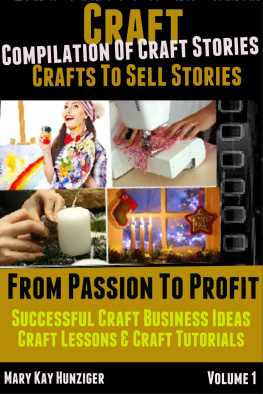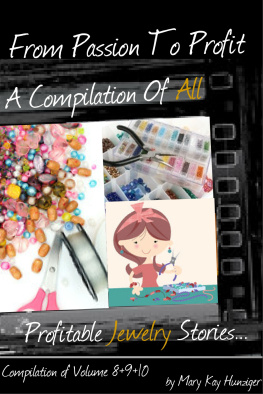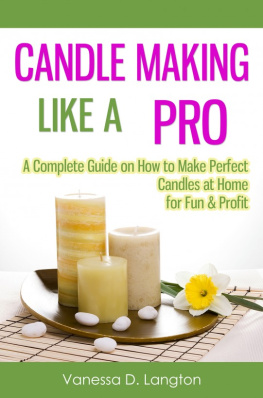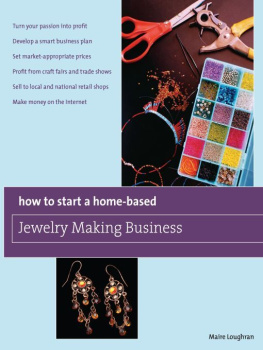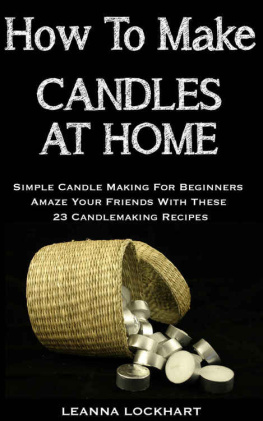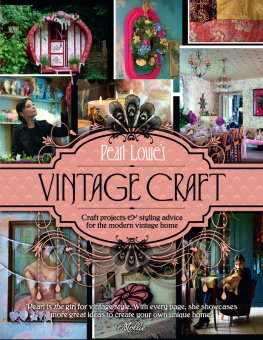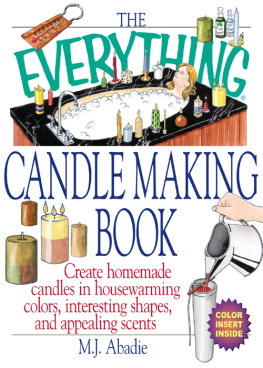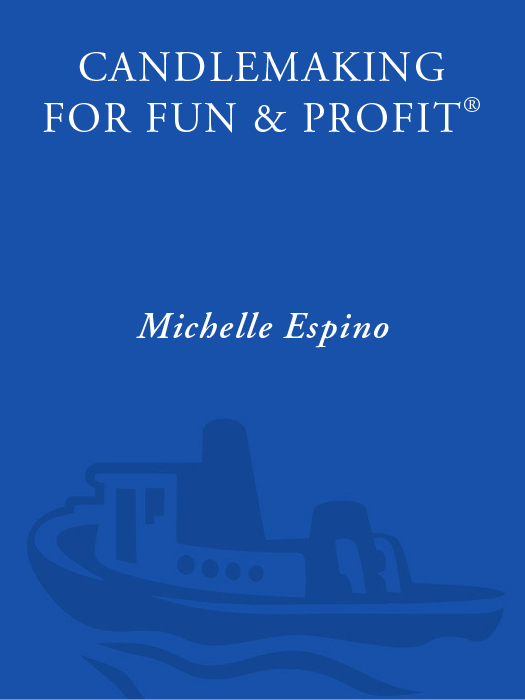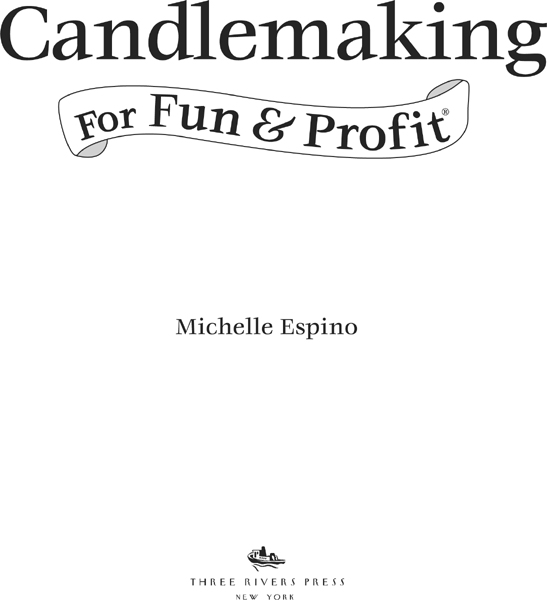Contents
Part One:
1:
2:
3:
4:
5:
6:
Part Two:
7:
8:
9:
10:
11: A Mini-Course in Crafts-Business Basics
by Barbara Brabec
T HE F OR F UN & P ROFIT Series
Crocheting For Fun & Profit
Jewelry Making For Fun & Profit
Soapmaking For Fun & Profit
Introduction
SEVERAL YEARS AGO, A FRIEND showed me how to make my first candle. When I pulled it out of its mold, I realized my love for candlemaking. I was amazed at how easy it was to make that pretty purple candle, and I was determined to make more. Soon after that revelation, I converted my tiny kitchen into my first candlemaking studio. (I was in college back then, and I really didnt know how to cook food very well, so I was happy to find a purpose for my kitchen.)
Using only the instructions that came with my new candle molds, I made one candle after another, experimenting with all the colors, scents, and ingredients I could find. I discovered I had a passion for the candlemaking process and devoured every piece of related information I could get my hands on. Now I love getting away from my tech career as an information systems analyst by making candles as often as I can.
A Brief History of Candlemaking
Candlemaking was once a necessity. Before the advent of gas and electricity, people needed light to do things after the sun went down. Primitive lights were easily made out of strips of wood or dried plant stems dipped into grease or pine tar and lit. Torches and fire baskets also provided light for the earliest civilizations. Most early candles were made from tallow, a white, solid animal fat derived from sheep, pigs, and cows.
Beeswax, a huge improvement over tallow, was introduced to candlemaking in the Middle Ages. In thirteenth century Paris, the first guild of chandlers (the early word for candlemakers) went from house to house making candles. The fifteenth century saw the introduction of a mold suitable for casting candles. Tallow was the commoners candle wax. Tallow candles were stinky, smoky, and left a greasy residue. Beeswax, on the other hand, was a sweet-smelling, slow-burning luxury wax obtained from the combs of the honeybee. An expensive commodity, beeswax candles were reserved only for religious activities, ceremonial purposes, and the most affluent of families.
Around the world, different societies tried diverse (and some peculiar) ways to obtain light. Oily fish, even fatty birds on sticks, were utilized as crude candles in some northern parts of the world. The Japanese tried boiling insects to obtain wax. American colonists learned that the waxy fruit of the bayberry bush produced green, woodsy-sweet scented candles, but it took too long to extract the wax from the berries to make them practical.
Major changes in candlemaking occurred with the growth of the whaling industry in the eighteenth century. Spermaceti, a wax crystallized from the oil of the sperm whale, became a common additive to tallow. Spermaceti wax reduced the stench of the tallow candle and made it harder and longer lasting.
Everyday kitchen candles were made by dipping several wicks draped over a stick into a large vat of tallow. Candlemaking was a necessary home craft until it became one of the first trades to industrialize due to the continual need for light.
The nineteenth century brought a series of milestones that spurred the mass production of candles:
1823Stearin, a white, crystalline substance found in most animal and vegetable fats was isolated from tallow. The addition of extra stearin to tallow produced a less smoky, harder candle.
1825A Frenchman developed the braided wick, which greatly increased the burning quality of candles.
1827Another Frenchman pioneered the match, which shortened the time and effort of lighting candles.
1834Joseph Morgan invented a candlemaking machine that could make 1,500 candles per hour.
1836Palmatine, a palm oil derivative similar to stearin, was patented as a wax alternative.
1850A breakthrough in candlemaking materialized with the development of commercial paraffin, a wax by-product of petroleum distillation. Paraffin was brighter, cleaner, and more longer burning than tallow.
Quality, affordable candles were finally achieved and easily mass-produced with the combination of the braided wick, paraffin, and stearin. This new golden era of candlemaking was short lived, however, as the need for candles faded after the arrival of kerosene lamps in 1857 and the introduction of the light bulb in 1879.
Now, candles have become popular pieces of home decoration in any style of modern living, as well as therapeutic devices for todays fast-paced, high-tech world. According to the National Candle Association, candles are used in seven out of ten households today. People enjoy the relaxing benefits of the soft glow of candlelight after a hard days work, and scented candles have always been a popular medium for home aromatherapy and fragrance.
How to Use This Book
Whether you want to learn candlemaking as a hobby or for a source of income, you will find everything you need in this book to develop your skills. The goal of the first half of the book is to teach you candlemaking from a structural perspective and encourage you to develop your own candlemaking style. Trying the different candlemaking methods I cover is the best way to learn a wide range of techniques. This will allow you to discover all the concoctions of ingredients possible for a candle recipe and to create any type of candle, limited only by your imagination. The second half of this book comprises what you need to know to profit from your new skills, including pricing your work, advertising your business, and learning the basics of crafting as a business.
Even if you already have candlemaking experience, you will find this book a handy information reference and a great source for inspiring ideas to raise your craft to higher levels of challenge. At the end of this book is an extensive resource section, listing books, periodicals, suppliers, associations, and Web sites for candlemakers at all levels of expertise. My goal in writing this book is to provide you with a creative, exploratory approach to candlemaking. I hope you will enjoy it enough to make it your favorite craft. Good luck!
Part One
For Fun

The Joy of
Candlemaking

THE VALUE OF CANDLEMAKING as a hobby today is that people love candles, and love giving them as gifts to friends, family, and themselves. In this age of mass production, it is a special gift to receive a unique, handcrafted candle that conveys the quality of its ingredients and the personality of its maker.


